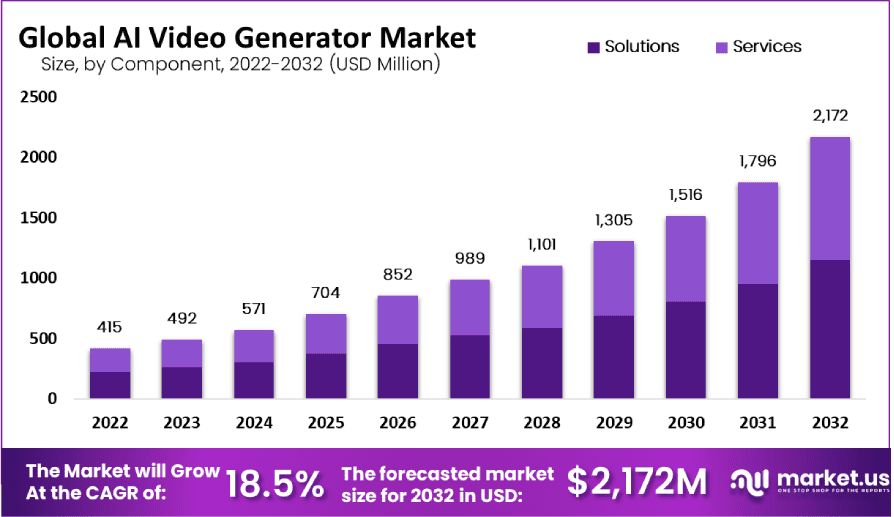The creator economy is booming, but for aspiring video artists, filmmakers, and content creators, the barriers to entry have often been prohibitively high. Professional-grade software, expensive camera equipment, and the steep learning curve associated with complex post-production workflows have traditionally separated amateurs from polished professionals. However, a seismic shift is underway, driven by the rapid proliferation of powerful, open-source Artificial Intelligence. This new wave of technology is not just an incremental update; it’s a paradigm shift, dismantling old barriers and democratizing the art of video creation for everyone. This is the biggest story in AI Tools for Creators News right now, signaling a future where imagination, not budget, is the primary limit to what can be achieved on screen.
We are moving beyond simple filters and automated captions into an era of generative video, where complex scenes, characters, and effects can be conjured from a simple text prompt. As major technology companies begin to release their foundational models to the public, a vibrant ecosystem of community-driven innovation is exploding. This article delves into this transformative landscape, exploring how open-source AI is reshaping the video production pipeline, the profound implications for creators of all levels, and the practical steps you can take to harness this power today.
The New Frontier: Understanding Open-Source AI in Video Production
For years, cutting-edge AI has been locked away in the proprietary systems of large corporations. Today, the landscape is changing dramatically. The rise of open-source AI models represents a fundamental democratization of technology, handing the keys to powerful creative engines directly to the global community of developers and artists. This movement is a cornerstone of recent AI Research / Prototypes News and is fundamentally altering the creative toolkit.
What Makes Open-Source AI a Game-Changer?
Unlike closed-source or “proprietary” AI systems, where the underlying code is a guarded secret, open-source models are transparent. Their architecture and, often, their training data are publicly available. This has several profound consequences:
- Accessibility: Creators are no longer beholden to expensive subscription models. They can access, run, and modify these tools, often for free, provided they have the necessary computing power. This lowers the financial barrier to entry significantly.
- Customization: Developers and tech-savvy artists can fine-tune these models on their own datasets. Imagine an animator training a model specifically on their unique art style to generate new scenes that perfectly match their aesthetic.
- Rapid Innovation: When a global community collaborates, progress accelerates exponentially. A bug fixed by a developer in Brazil can benefit a filmmaker in Japan overnight. New features and capabilities are constantly being added by a decentralized network of innovators, a trend often highlighted in AI Edge Devices News as models become more efficient for local processing.
Core Capabilities of Modern AI Video Tools
The latest generation of AI video tools offers a stunning array of capabilities that address nearly every stage of the production process. These advancements are a hot topic in AI-enabled Cameras & Vision News, as they redefine what a “camera” can capture.
- Text-to-Video and Image-to-Video: This is the headline feature. Creators can type a descriptive prompt like “a cinematic shot of a lone astronaut walking on a red Martian desert, sunset, 8K, hyperrealistic” and receive a short video clip matching the description. Similarly, a still image can be animated, bringing a photograph or digital painting to life.
- AI-Powered Editing: AI can automate tedious editing tasks. This includes automatically cutting out silences and filler words from interviews, generating transcriptions and subtitles with near-perfect accuracy, and even performing intelligent “scene edit detection” on long clips.
- Generative Audio and Music: The visual realm isn’t the only focus. As reported in AI Audio / Speakers News, AI can now generate royalty-free background music tailored to the mood of a scene, create realistic sound effects from text descriptions, or even clone a voice for narration (with ethical considerations).
- Style Transfer and Digital Restoration: These tools can apply the aesthetic of a famous painting to a video clip or use AI algorithms to upscale, de-noise, and colorize old, low-resolution footage, breathing new life into archival material.
Deconstructing the AI Video Workflow: From Prompt to Final Cut

Integrating AI into the video creation process isn’t about replacing the artist; it’s about augmenting their abilities and supercharging their workflow. A modern, AI-assisted production pipeline allows for unprecedented speed and creative exploration, a process that is increasingly accessible through developments covered in AI Phone & Mobile Devices News, as powerful apps bring these features to our pockets.
Phase 1: AI-Accelerated Pre-Production
Before a single frame is shot, AI can be an invaluable creative partner. Instead of spending days sketching storyboards, a director can generate dozens of visual concepts in minutes. By feeding a script or scene description into an image generation model, they can visualize camera angles, lighting setups, and character designs. This allows for rapid iteration and helps align the entire creative team on a visual direction long before production begins. For example, a creator making a fantasy short film could prompt: “storyboard panel, wide angle, two elves standing before a glowing ancient tree, moody lighting, ink sketch style.” The AI would provide a visual reference that can be refined and shared instantly.
Phase 2: The New Age of Asset Generation
This is where generative video models truly shine. Traditionally, creating a shot of a dragon flying over a castle would require a massive budget for a CGI team. Now, an independent creator can generate that same shot, or multiple variations of it, from a prompt. The workflow becomes iterative:
- Initial Prompt: “A majestic black dragon flies over a medieval castle during a storm.”
- Refinement: The creator might find the motion too stiff. They can add parameters to the prompt: “smooth, gliding motion,” or “dynamic camera tracking shot.”
- Element Isolation: They might generate the dragon and the castle background separately to have more control during compositing.
Phase 3: Intelligent Post-Production
Once the raw assets—a mix of real-world footage and AI-generated clips—are gathered, AI continues to streamline the process. An editor can use an AI tool to automatically create a rough cut of an interview by analyzing the transcript for the most compelling soundbites. Color grading, a highly technical skill, can be simplified by using AI to match the color palette of a scene to a reference image, like a still from a favorite film. AI-powered audio tools can automatically remove background noise from a dialogue track or balance audio levels, saving hours of meticulous manual work. This fusion of human oversight and AI efficiency is the future of post-production.
Implications and Insights: A Paradigm Shift for Creativity
The rise of accessible, open-source AI video tools is more than just a technological advancement; it’s a cultural one. It reshapes who can be a creator, what kind of stories can be told, and how we think about the nature of digital art itself. The ripple effects are being felt across adjacent fields, from AI in Gaming Gadgets News, where procedural content generation is key, to AI for Accessibility Devices News, where these tools can empower creators with physical limitations.
Democratizing High-End Production

For decades, the visual effects (VFX) and animation industries have been dominated by large studios with immense resources. Open-source AI dismantles this exclusivity. An independent filmmaker in a developing country can now access tools to create sci-fi epics or fantasy worlds that were previously unimaginable. A small marketing agency can produce high-quality, animated advertisements without hiring a dedicated animation team. This levels the playing field, allowing talent and storytelling to triumph over budget constraints. This democratization is a recurring theme in technology, echoing trends seen in Robotics News and Drones & AI News, where complex technology becomes more accessible over time.
Fostering Unprecedented Innovation and Experimentation
The open-source nature of these tools creates a feedback loop of explosive innovation. When a new model is released, thousands of developers and artists immediately begin to experiment, pushing its boundaries, finding its flaws, and building new applications on top of it. This collaborative environment leads to new artistic styles and techniques emerging at a breathtaking pace. We are already seeing artists combine AI video generation with neural interfaces to create art from thought, a concept straight out of Neural Interfaces News. This rapid, decentralized R&D means the tools are evolving faster than any single corporation could manage, constantly unlocking new creative possibilities.
Navigating the New Challenges and Ethical Minefields
With great power comes great responsibility. The same technology that can create beautiful art can also be used to generate convincing deepfakes and spread misinformation. The ethical implications are significant, and the industry is grappling with them in real-time. Key challenges include:
- Copyright and Data Provenance: AI models are trained on vast datasets of existing images and videos. The question of whether this constitutes fair use or copyright infringement is the subject of ongoing legal battles.
- Authenticity and Trust: As AI-generated content becomes indistinguishable from reality, it poses a threat to digital trust. Developing robust watermarking and detection technologies, a topic relevant to AI Security Gadgets News, is crucial.
- Creative Homogenization: If all creators use the same foundational models, there’s a risk that a generic “AI style” could emerge, stifling unique artistic voices. The key will be for artists to use AI as a component in their workflow, not as a total replacement for their own creativity.
Pros, Cons, and Best Practices for Creators
Harnessing the power of AI video tools requires a new mindset and skillset. It’s not about mindlessly entering prompts but about engaging in a creative dialogue with the machine. Here are some practical recommendations for creators looking to dive in.

Recommendations and Best Practices
- Start with a Strong Vision: AI is a powerful collaborator, but it’s not a visionary. Before you generate anything, have a clear idea of the story you want to tell, the mood you want to evoke, and the style you’re aiming for. Your creative direction is the most important input.
- Master the Art of the Prompt: Prompt engineering is the new essential skill. Be specific and descriptive. Use keywords related to cinematography (e.g., “wide shot,” “dolly zoom,” “golden hour lighting”), art styles (“impressionistic,” “cyberpunk,” “Ghibli-inspired”), and emotional tone.
- Embrace the Hybrid Workflow: The most compelling work today combines AI-generated elements with traditionally shot footage and human editing. Use AI to create an impossible establishing shot, but use a real camera for an intimate character moment. Use AI to generate background textures, but composite and grade them yourself. This preserves your unique artistic fingerprint.
- Iterate, Iterate, Iterate: Don’t expect perfection on the first try. Generative AI is a process of discovery. Generate multiple clips, experiment with different prompts, and see what the AI produces. Sometimes the “happy accidents” can lead to the most interesting creative breakthroughs.
Pros and Cons at a Glance
Pros:
- Dramatically reduces production costs and time.
- Enables creation of visuals previously impossible for individuals.
- Automates tedious tasks, freeing up creators to focus on creativity.
- Open-source nature fosters rapid, community-driven innovation.
Cons:
- Potential for misuse in creating misinformation (deepfakes).
- Unresolved legal and ethical questions around copyright.
- Can have a steep learning curve for non-technical users.
- Risk of over-reliance leading to a generic, uninspired visual style.
Conclusion: The Future of Storytelling is a Collaboration
The emergence of powerful, open-source AI video tools marks a pivotal moment in the history of media creation. We are at the very beginning of a new creative renaissance, one that promises to be more inclusive, experimental, and visually spectacular than ever before. This is not the end of human creativity; it is the dawn of a new partnership. The artists who thrive in this new era will be those who learn to collaborate with AI, using it as an infinitely powerful paintbrush to bring their unique visions to life. While the technology will continue to evolve at a dizzying pace, the core of great content will remain unchanged: a compelling story, a unique perspective, and a human heart. The tools are simply becoming more powerful, and the canvas is now limitless.










